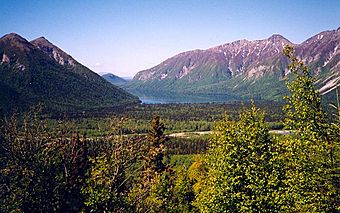Kijik, Alaska facts for kids
|
Kijik Archeological District
|
|

Scenery in the district
|
|
| Lua error in Module:Location_map at line 420: attempt to index field 'wikibase' (a nil value). | |
| Location | Address restricted , Lake Clark National Park and Preserve |
|---|---|
| Nearest city | Port Alsworth, Alaska |
| Area | 1,920 acres (780 ha) |
| NRHP reference No. | 94001644 |
Quick facts for kids Significant dates |
|
| Added to NRHP | October 12, 1994 |
| Designated NHLD | October 12, 1994 |
|
Kijik Historic District
|
|
| Location | Address restricted , Lake Clark National Park and Preserve |
| Nearest city | Port Alsworth, Alaska |
| Area | 12 acres (4.9 ha) |
| NRHP reference No. | 79000410 |
| Added to NRHP | January 29, 1979 |
Kijik (pronounced KEE-jik) is a fascinating ghost town in Alaska. It was once a lively village for the Athabascan people, specifically the Dena'ina. Kijik was built right on the shores of Lake Clark, surrounded by the beautiful Alaska Range mountains.
In 1880, about 91 people lived in Kijik. However, over time, the population slowly decreased. By 1904, only about 25 people remained. Today, the village is completely empty. It is now part of the amazing Lake Clark National Park and Preserve.
Contents
Discovering Kijik's Past
Early Research and Relocation
Scientists and historians started studying the historic part of Kijik in the 1960s. They wanted to learn more about the people who lived there. They talked to older Dena'ina people in Nondalton. These elders shared stories about how the people of Kijik moved to a place called Old Nondalton. This move happened in the early 1900s.
People likely moved to be closer to places where they could trade goods. They also wanted to be nearer to fish canneries in Bristol Bay. A group exploring the area in 1909 found Kijik already abandoned.
Archaeological Digs at the Village Site
In 1966, a big archaeological dig took place at the old village. Archaeologists found the remains of twelve log houses. Many of these houses were probably moved to Old Nondalton when the villagers left. They also found two larger structures that seemed to be for the whole community. These discoveries help us understand how the Dena'ina people lived.
Kijik's Special Recognition
Becoming a Historic District
In 1979, a 12-acre part of the Kijik village site was added to the National Register of Historic Places. This means it was recognized as an important historic district in the United States.
A National Historic Landmark District
Later, in 1994, a much larger area around Kijik became a National Historic Landmark District. This area covers about 1,920 acres. It includes many ancient sites that show how people lived and used the land since at least the 1100s. Kijik is special because it has so many sites related to the inland Dena'ina people.
Different Names for Kijik
Throughout its history, Kijik was known by several other names. Some people called it "Lake Clark Village." Other names included "Nijik," "Nikhkak," and "Old Keegik." Even its current name, Kijik, has been spelled in many ways. You might see it as "Keechik," "Keeghik," "Keejik," "Keggik," "Keygik," "Kichak," "Kichik," "Kilchik," or "Kilchikh."
Population Changes Over Time
| Historical population | |||
|---|---|---|---|
| Census | Pop. | %± | |
| 1880 | 91 | — | |
| 1890 | 42 | −53.8% | |
| U.S. Decennial Census | |||
Kijik first appeared on the U.S. Census in 1880. It was listed as an unincorporated village called "Kichik." It was listed again in 1890 as "Nikhkak." After 1900, the village was abandoned. It was empty by 1909 and has not been on the census since.

